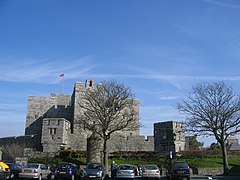Castle Rushen
| Castle Rushen | |
|---|---|

Castle Rushen seen from Castletown's market square.
|
|
| General information | |
| Town or city | Castletown |
| Country | Isle of Man |
| Completed | 16th century |
| Design and construction | |
| Architect | Several |
Castle Rushen (Manx: Cashtal Rosien) is a medieval castle located in the Isle of Man's historic capital, Castletown, in the south of the island. It towers over the Market Square to the south-east and the harbour to the north-east. The castle is amongst the best examples of medieval castles on the British Isles, and is still in use as a court house, museum and educational centre.
The castle cannot be dated to the nearest 100 years, although construction is thought to have taken place during the reigns of the late 12th century and early 13th century rulers of the Isle of Man – the Kings of Mann and the Isles. The last such king, Magnús Óláfsson, is recorded in the Chronicle of Mann to have died at the castle in 1265. The original Castle Rushen consisted of a central square stone tower, or keep. The site was also fortified to guard the entrance to the Silver Burn. From its early beginnings, the castle was continually developed by successive rulers of Mann between the 13th and 16th century. The limestone walls dominated much of the surrounding landscape, serving as a point of dominance for the various rulers of the Isle of Man. By 1313, the original keep had been reinforced with towers to the west and south. In the 14th century, an east tower, gatehouses, and curtain wall were added. Although parts of the castle were destroyed by Robert the Bruce in 1313, the damage was rebuilt by William Montacute, King of Mann by the year 1344.
The keep of Castle Rushen's first line of defence is an outer wall, 25 feet (7.6 m) high and 7 feet (2.1 m) thick. Attached to the wall are five towers, which in the post-defensive era of Castle Rushen were used for civilian administrative functions. The keep itself has walls 12 feet (3.7 m) thick at the base and 7 feet (2.1 m) thick at the top. Four towers sit atop the keep, the main one in the north rising to a height of 80 feet (24 m) and other three to around 70 feet (21 m).
...
Wikipedia
